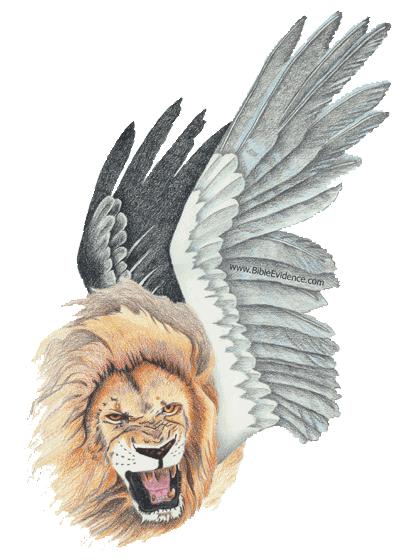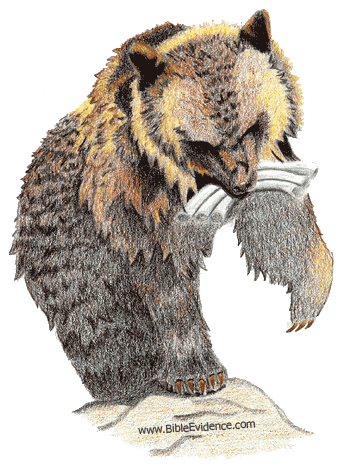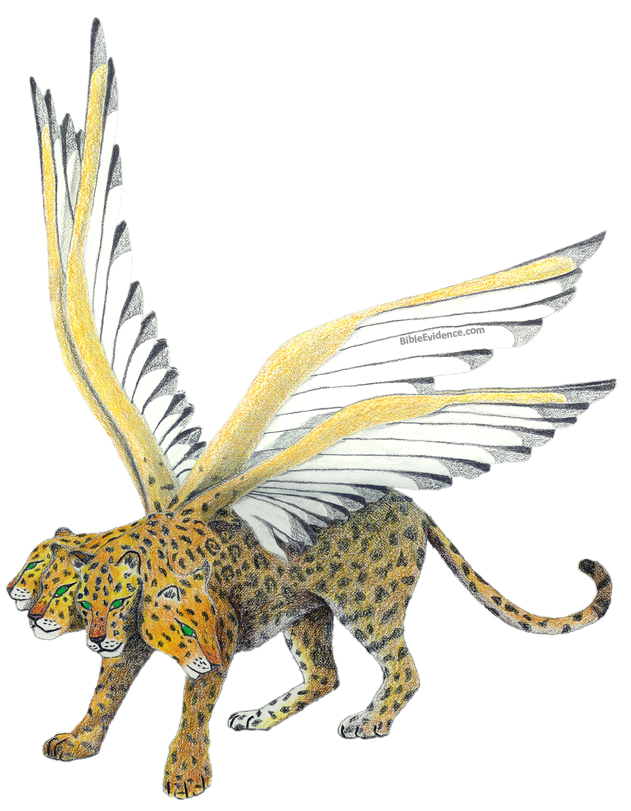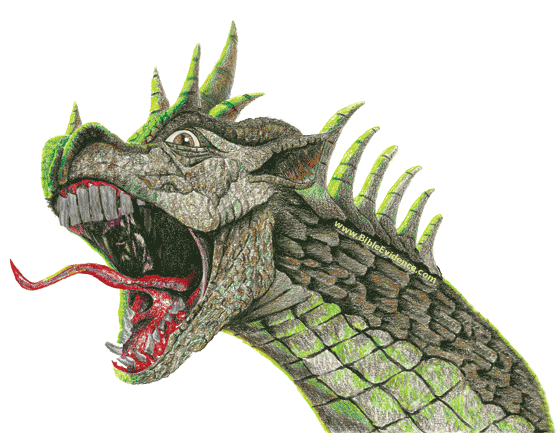
The Four Beasts (Daniel 7)
Overview
Bible Passage:
Read the prophecy in Daniel 7.Theme:
Realms that rule over God's people until the heavenly court gives Jesus the realm.Overview:
Building upon Daniel's vision in chapter 2, this prophecy reveals more detail about the realms that would rule over God's people from Daniel's day until the second coming of Christ. A little horn on the fourth beast becomes the focal point, which is explained as a very unique power that speaks against God, tries to change God's law, is pompous and prevails against the saints for a certain time period. This is followed by a court scene with a multitude of heavenly beings where the Ancient of Days sits and books are examined and judgment rendered, which brings an end to the Little Horn's power and enables the saints to possess the kingdom.Main Starting Points:
There will only be four realms that rule where the large part of God's people dwell, until God's everlasting kingdom (v. 27). We know from history and other Bible verses the identity of the four kingdoms. They parallel the same four kingdoms outlined in the prophecy of Nebuchadnezzar's Image in Daniel 2.Verse-By-Verse
Daniel 7:1 In the first year of Belshazzar king of Babylon Daniel had a dream and visions of his head upon his bed: then he wrote the dream, and told the sum of the matters.
Angels' Interpretation: 16 I came near unto one of them that stood by, and asked him the truth of all this. So he told me, and made me know the interpretation of the things.
The first year of Belshazzar was 550 BC.
Daniel 7:2 Daniel spake and said, I saw in my vision by night, and, behold, the four winds of the heaven strove upon the great sea.
Winds = Disaster, war, strife (Jeremiah 49:36, 37).
Four = All directions of the compass/earth (Dan. 11:4). In Revelation, four winds are held back so no one is harmed (Rev. 7:1-2).
Sea/Water = Multitudes, peoples, nations (Rev. 17:15)
Daniel 7:3 And four great beasts came up from the sea, diverse one from another.
Angels' Interpretation: 17 These great beasts, which are four, are four kings, which shall arise out of the earth.
23 Thus he said, The fourth beast shall be the fourth kingdom upon earth...
Beast = The angel reveals that each beast represents a kingdom/realm (v. 17, 23).
Daniel 7:4 The first was like a lion, and had eagle's wings: I beheld till the wings thereof were plucked, and it was lifted up from the earth, and made stand upon the feet as a man, and a man's heart was given to it.
 Lion = Babylon (609 BC to 539 BC). We already know from Daniel 2 the identity of the four realms. This first beast resembles a lion, which is thought of as the most powerful animal (king of the beasts), just like Babylon (also the head of gold in Daniel 2) was the greatest kingdom.
Lion = Babylon (609 BC to 539 BC). We already know from Daniel 2 the identity of the four realms. This first beast resembles a lion, which is thought of as the most powerful animal (king of the beasts), just like Babylon (also the head of gold in Daniel 2) was the greatest kingdom.
Wings = Speed. The Babylonians launched attacks swiftly, as symbolized by the eagle's wings. "Our persecutors are swifter than the eagles of the heaven" (Lam. 4:19). However, the advancement of their conquest was stayed, as represented by the wings being plucked.
Man's Heart = Rational and weak, as compared to a beast. Giving the lion a man's heart symbolizes the change in Babylon's character from its initial fierceness under Nebuchadnezzar to its later relative calmness and rationality (see Dan. 4:16) under later rulers. Being made to stand up as a man after being on all fours as a powerful beast symbolizes a change in the realm to comparable weakness after Nebuchadnezzar's death.
Daniel 7:5 And behold another beast, a second, like to a bear, and it raised up itself on one side, and it had three ribs in the mouth of it between the teeth of it: and they said thus unto it, Arise, devour much flesh.
 Bear = Medo Persia (539 to 331 BC). The second beast was like a bear. It represents Medo-Persia.
Bear = Medo Persia (539 to 331 BC). The second beast was like a bear. It represents Medo-Persia.
Raised on one side = An imbalance of power (Persia was stronger than the Medes).
Three ribs in its mouth = The three main entities Medo-Persia conquered: Lydia (546 BC), Babylon (539 BC) and Egypt (525 BC). Cyrus the Great, of Persia, conquered the middle east. His son, Cambyses, extended the kingdom, also capturing Egypt.
Daniel 7:6 After this I beheld, and lo another, like a leopard, which had upon the back of it four wings of a fowl; the beast had also four heads; and dominion was given to it.
 Leopard = Greece (331 to 168 BC). The third beast that appears in Daniel 7 resembles a leopard and symbolizes the third kingdom, Greece.
Wings = Speed (Lam. 4:19). The leopard is known for its speed (Hab. 1:8) and it's four wings represent the legendary extreme swiftness with which Alexander the Great conquered the mighty Persians and united Greece.
Leopard = Greece (331 to 168 BC). The third beast that appears in Daniel 7 resembles a leopard and symbolizes the third kingdom, Greece.
Wings = Speed (Lam. 4:19). The leopard is known for its speed (Hab. 1:8) and it's four wings represent the legendary extreme swiftness with which Alexander the Great conquered the mighty Persians and united Greece.
Four Heads = The four divisions of political power into which Greece divided after Alexander died: Ptolemy (Egypt, Palestine and parts of Syria), Lysimachus (Thrace and a large part of Asia minor), Cassander (Macedonia and some interest in Greece) and Seleucus (Persian Empire, part of Asia Minor, Northern Syria, Mesopotamia and the east).
Daniel 7:7 After this I saw in the night visions, and behold a fourth beast, dreadful and terrible, and strong exceedingly; and it had great iron teeth: it devoured and brake in pieces, and stamped the residue with the feet of it: and it was diverse from all the beasts that were before it; and it had ten horns.
Angels' Interpretation: 19 Then I would know the truth of the fourth beast, which was diverse from all the others, exceeding dreadful, whose teeth were of iron, and his nails of brass; which devoured, brake in pieces, and stamped the residue with his feet;
23 Thus he said, The fourth beast shall be the fourth kingdom upon earth, which shall be diverse from all kingdoms, and shall devour the whole earth, and shall tread it down, and break it in pieces.
24 And the ten horns out of this kingdom are ten kings that shall arise...
 Dreadful Beast = Rome (168 BC to Second Coming). The fourth beast seemed too terrible to describe! The kingdom that followed Greece was Rome, which was strong (symbolized by iron teeth, just like the iron legs in Nebuchadnezzar's image in Daniel 2), causing great fear (devouring, stamping - v. 19).
Dreadful Beast = Rome (168 BC to Second Coming). The fourth beast seemed too terrible to describe! The kingdom that followed Greece was Rome, which was strong (symbolized by iron teeth, just like the iron legs in Nebuchadnezzar's image in Daniel 2), causing great fear (devouring, stamping - v. 19).
10 horns = 10 kingdoms. A horn symbolizes a kingdom (Dan. 7:24, 8:8-9,21-23) within that beast's realm ("out of this kingdom"). (Note: The Little Horn rules for 1260 literal years, which provides additional evidence that horns symbolizes a kingdom or dominion, not just a single ruler.)
The fourth realm, Rome, divides into 10 kingdoms, just like the legs of iron divided into 10 toes in Daniel 2.This dividing occurred in the Roman Empire during the second through fifth centuries AD, Germanic tribes settled in Roman lands. Many of them were integrated into the army, to such a degree, that they gradually rose to fill positions of high commands. Imperial power deteriorated, and in 410 AD, Rome was looted, which led to the establishment of puppet emperors of German commanders. Eventually the last Roman emperor, Romulus Augustus, was deposed in 476 AD and the last western Roman military commander was overthrown in 486 AD. The 10 horns symbolize that Rome became a divided empire.
The kingdoms these ten horns most likely represent, along with their modern equivalents, are listed below. There were other people groups within the Roman Realm, however, they did not become established in a way to qualify as a kingdom when Rome decentralized. Some were being ruled by one of the ten kingdoms. The prophecy is focused on the western Roman Empire. The eastern half had been set up in the 4th century, and gradually became a completely separate entity. Though it still called itself Roman, by the 8th century it was a distinct realm, a Greek realm, separate from the western Roman realm and with no political authority in the west. Western Rome is where the division into ten kingdoms occurred. (See more information on the complexities of the Roman realm.)
- 1. Anglo-Saxons (English)
- 2. Franks (French)
- 3. Alemanni (Germans)
- 4. Lombards (Italians)
- 5. Suevi (Portuguese)
- 6. Visigoths (Spanish)
- 7. Burgundians (Swiss)
- 8. Heruli (conquered in 493 AD and faded out of history)
- 9. Vandals (conquered in 534 AD and lost distinctive ethnic identity)
- 10. Ostrogoths (withdrew from Rome in 538 AD, and absorbed into the Lombard Kingdom)
Daniel 7:8 I considered the horns, and, behold, there came up among them another little horn, before whom there were three of the first horns plucked up by the roots: and, behold, in this horn were eyes like the eyes of man, and a mouth speaking great things.
Angels' Interpretation: 20 And of the ten horns that were in his head, and of the other which came up, and before whom three fell; even of that horn that had eyes, and a mouth that spake very great things, whose look was more stout than his fellows.
21 I beheld, and the same horn made war with the saints, and prevailed against them;
24 And the ten horns out of this kingdom are ten kings that shall arise: and another shall rise after them; and he shall be diverse from the first, and he shall subdue three kings.
25 And he shall speak great words against the most High, and shall wear out the saints of the most High, and think to change times and laws: and they shall be given into his hand until a time and times and the dividing of time.
 Little Horn = Papal-led Rome. The Dreadful Beast grew a mysterious horn, which becomes a focal point in the prophecy. Many identifying characteristics of this Little Horn are provided in the prophecy, which all fit the very influential and prominent Church of Rome in the middle ages. See "Characteristics of the Little Horn" to examine each characteristic of the Little Horn and its fulfillment in the Papacy.
Little Horn = Papal-led Rome. The Dreadful Beast grew a mysterious horn, which becomes a focal point in the prophecy. Many identifying characteristics of this Little Horn are provided in the prophecy, which all fit the very influential and prominent Church of Rome in the middle ages. See "Characteristics of the Little Horn" to examine each characteristic of the Little Horn and its fulfillment in the Papacy.
Important dates marking the rise of the Church in Rome to such a powerful position can be seen in the chart "The Papacy Power Curve".
Time and times and the dividing of time = 1260 years. The papacy would rule ecclesiastically for 1260 years, from 538 to 1798 AD. See 1260 Days in Bible Prophecy for more information on how to calculate prophetic time and this reoccurring time period.
Daniel 7:9 I beheld till the thrones were cast down, and the Ancient of days did sit, whose garment was white as snow, and the hair of his head like the pure wool: his throne was like the fiery flame, and his wheels as burning fire.
Angels' Interpretation: 22 Until the Ancient of days came, and judgment was given to the saints of the most High; and the time came that the saints possessed the kingdom.
Here is a glimpse into heaven where we see the throne of God and the workings of His government. This description has similarities to the amazing accounts in Ezekiel 1 and Revelation 4 where more details are given.
Ancient of days = God the Father. The word translated to "Ancient" is only used here in Daniel 7. It is depicting someone very aged in years who is overseeing this court scene. In verse 13-14 one like the son of man is given a kingdom by the Ancient of days. It is God the Father who gives Jesus the kingdom (Ez. 21:26-27, Lk 1:32-33, Lk 12:32, Rev. 11:15). After Jesus was resurrected, He ascended to heaven and works at the right hand of God the Father (1 Pet. 3:21-22, Heb. 8:1,12:2). We know that God the Father gave all judgment to the Son (John 5:22), so we see here that God the Father is the one presiding over the court.
Throne = Place of rule/authority. This judgment scene occurs where the "Ancient of days" sits down and has a throne (Dan. 7:9). Only God (Father, Son and Holy Spirit) have been here since days began (Psalm 90:2). The Lord's throne is in heaven (Psalm 11:4) (Rev. 4:2). "But I say unto you, Swear not at all; neither by heaven; for it is God's throne" (Matt. 5:34). A divine being is presiding over this court and it is located in heaven.
Garment white as snow = Pure character. Clothing symbolizes character (Zech. 3:3-4, Is. 61:10, Job 29:14) and white symbolizes the purity of the character (Rev. 19:8, 7:14, 12:11).
Hair like pure wool = Purity. Jesus is also described as having white hair like wool in Rev. 1:14. It emphasizes their purity and trustworthiness.
Fiery throne / fiery stream = Holiness, consuming fire (Heb 12:29). God dwells in unapproachable light (1 Tim. 6:16)
Wheels as burning fire = Holy providence. The word for wheel is also translated whirlwind or rolling thing. We get the sense of an unstoppable, stay-out-of-the-way, efficient, incomprehensible apparatus. In Ezekiel the wheels go in perfect unison, portraying the omnipresence and omniscience providence of God.
Daniel 7:10 A fiery stream issued and came forth from before him: thousand thousands ministered unto him, and ten thousand times ten thousand stood before him: the judgment was set, and the books were opened.
Angels' Interpretation: 26 But the judgment shall sit, and they shall take away his dominion, to consume and to destroy it unto the end.
Fiery stream came forth = The holiness and purity flows forth from God to do its work. There is an abundance.
A thousand thousands who minister = Angels who minister (Psalm 103:19-21, Ps. 104:3-4). Angels are ministers, or servants, of God. He rides on the clouds (Ps. 104:3-4). The clouds are His chariot and his chariot are the angels (Ps. 68:17). Here in Daniel 7, the clouds, which represent angels, bring Jesus near to the throne (v. 13).
10 Thousand times 10 Thousand = Angels who witness. The same reference to "ten thousand times ten thousand" occurs in Revelation, which depicts angels around the throne. Revelation 5:11 "And I beheld, and I heard the voice of many angels round about the throne and the beasts and the elders: and the number of them was ten thousand times ten thousand, and thousands of thousands."
Judgment was set = Pre-Advent Judgment. See "The Court Scene".
Books were opened = Investigation of records. See "The Books of the Judgment".
Daniel 7:11 I beheld then because of the voice of the great words which the horn spake: I beheld even till the beast was slain, and his body destroyed, and given to the burning flame. 12 As concerning the rest of the beasts, they had their dominion taken away: yet their lives were prolonged for a season and time.
The first three beasts (Babylon, Medo-Persia, Greece) already had their dominion taken away years ago, but the 4th beast doesn't lose dominion until the second coming. At that point, all of the kingdoms of earth are destroyed (burned) at Jesus' second coming. Note the way the NIV clarifies this: "Then I continued to watch because of the boastful words the horn was speaking. I kept looking until the beast was slain and its body destroyed and thrown into the blazing fire. (The other beasts had been stripped of their authority, but were allowed to live for a period of time.)" (Daniel 7:11-12).
13 I saw in the night visions, and, behold, one like the Son of man came with the clouds of heaven, and came to the Ancient of days, and they brought him near before him.
Son of man = Jesus. The Old Testament uses the phrase "son of man" to refer to various individuals. In Daniel 8:17 the "son of man" refers to Daniel. The New Testament uses "Son of man" extensively to refer to Jesus (Matthew 9:6, 12:8, 16:27). How do we know the identity of this "Son of man"?
- (A) When we read the verse immediately following (Dan. 7:14), the same being (Son of man) receives an everlasting kindgom. We know this is Jesus from other Bible verses (2 Pet. 1:11, Luke 19:11-27, Rev. 11:17).
- (B) The Father gives the work of judgment to Jesus the Son (John 5:20-30). God the Father is presiding over the court, but He has given all judgment to the Son. See also 2 Tim. 4:1 (Note that the judgment isn't limited to the time of His second coming, as the NIV and other versions clarify. "4 In the presence of God and of Christ Jesus, who will judge the living and the dead, and in view of his appearing and his kingdom, I give you this charge: 2 Preach the word; be prepared in season and out of season; correct, rebuke and encourage - with great patience and careful instruction.")
- (C) There are also clues in other prophecies as we see Jesus described as "One like unto the Son of man" as the priest of the heavenly sanctuary (Rev. 1:13) and as one who sits on the cloud and reaps the harvest (Rev. 14:14.
Brought him near before him = Jesus moves to a new location in heaven to signify a new phase of His ministry. After Jesus rose from the grave, He went to heaven (1 Peter 3:22), and has been ministering for us until he receives the kingdom (Matt. 25:31, Rev. 11:15) and returns to earth a second time. This prophecy brings to light a time, prior to His return, when He moves to a new location, signifying a new phase of His ministry. This same shift in location is outlined in the earthly sanctuary services, which symbolize the plan of salvation and the activities of Jesus during His ministry. In the earthly service, the priest would minister in the Holy Place every day. Then, once at the end of the year, he would minister in the Most Holy Place. This event was referred to as the Day of Atonement. All year, during the daily service, sins would be confessed over a lamb and symbolically transferred into the sanctuary by the priest. Then, on the Day of Atonement, the sins would symbolically be removed from the sanctuary leaving all the people, priests, altar and tabernacle clean (Lev. 16:33-34). This new phase, or location, of Jesus' ministry involves looking at books of record.
Daniel 7:14 And there was given him dominion, and glory, and a kingdom, that all people, nations, and languages, should serve him: his dominion is an everlasting dominion, which shall not pass away, and his kingdom that which shall not be destroyed.
As a result of investigating the books, the decision is announced that Jesus receives the kingdom (Rev. 11:15). Human probation closes, and all other earthly realms are destroyed.
18 But the saints of the most High shall take the kingdom, and possess the kingdom for ever, even for ever and ever.
27 And the kingdom and dominion, and the greatness of the kingdom under the whole heaven, shall be given to the people of the saints of the most High, whose kingdom is an everlasting kingdom, and all dominions shall serve and obey him.
When Jesus returns to earth He destroys all earthly powers (note that this corresponds to the time when the stone strikes the image in Daniel's first vision). Jesus' realm is the last realm on earth, because it continues forever. Extraordinarily, He shares it with the saints. The final realm on this earth will have Christ for its ruler and those who choose to follow Him will be the ones entrusted with governing this everlasting kingdom. He shares rulership of the kingdom with His people (see also 2 Tim. 2:12, Rev. 22:4-5).
Daniel 7:15 I Daniel was grieved in my spirit in the midst of my body, and the visions of my head troubled me.
Angels' Interpretation: 28 Hitherto is the end of the matter. As for me Daniel, my cogitations much troubled me, and my countenance changed in me: but I kept the matter in my heart.
The vision troubled Daniel greatly.
Time Line

(click on image to enlarge)
Additional Resources:
The Four Beasts (interactive presentation)
1260 Days
Books of the Judgment
Court Scene
Little Horn
Papacy Power Curve
Continue to the next study: The 2300 Days (Dan. 8)
Daniel 7:1 In the first year of Belshazzar king of Babylon Daniel had a dream and visions of his head upon his bed: then he wrote the dream, and told the sum of the matters.
Angels' Interpretation: 16 I came near unto one of them that stood by, and asked him the truth of all this. So he told me, and made me know the interpretation of the things.
Daniel 7:2 Daniel spake and said, I saw in my vision by night, and, behold, the four winds of the heaven strove upon the great sea.
Daniel 7:3 And four great beasts came up from the sea, diverse one from another.
Angels' Interpretation: 17 These great beasts, which are four, are four kings, which shall arise out of the earth.
23 Thus he said, The fourth beast shall be the fourth kingdom upon earth...
Daniel 7:4 The first was like a lion, and had eagle's wings: I beheld till the wings thereof were plucked, and it was lifted up from the earth, and made stand upon the feet as a man, and a man's heart was given to it.
Daniel 7:5 And behold another beast, a second, like to a bear, and it raised up itself on one side, and it had three ribs in the mouth of it between the teeth of it: and they said thus unto it, Arise, devour much flesh.
Daniel 7:6 After this I beheld, and lo another, like a leopard, which had upon the back of it four wings of a fowl; the beast had also four heads; and dominion was given to it.
Daniel 7:7 After this I saw in the night visions, and behold a fourth beast, dreadful and terrible, and strong exceedingly; and it had great iron teeth: it devoured and brake in pieces, and stamped the residue with the feet of it: and it was diverse from all the beasts that were before it; and it had ten horns.
Angels' Interpretation: 19 Then I would know the truth of the fourth beast, which was diverse from all the others, exceeding dreadful, whose teeth were of iron, and his nails of brass; which devoured, brake in pieces, and stamped the residue with his feet;
23 Thus he said, The fourth beast shall be the fourth kingdom upon earth, which shall be diverse from all kingdoms, and shall devour the whole earth, and shall tread it down, and break it in pieces.
24 And the ten horns out of this kingdom are ten kings that shall arise...
Daniel 7:8 I considered the horns, and, behold, there came up among them another little horn, before whom there were three of the first horns plucked up by the roots: and, behold, in this horn were eyes like the eyes of man, and a mouth speaking great things.
Angels' Interpretation: 20 And of the ten horns that were in his head, and of the other which came up, and before whom three fell; even of that horn that had eyes, and a mouth that spake very great things, whose look was more stout than his fellows.
21 I beheld, and the same horn made war with the saints, and prevailed against them;
24 And the ten horns out of this kingdom are ten kings that shall arise: and another shall rise after them; and he shall be diverse from the first, and he shall subdue three kings.
25 And he shall speak great words against the most High, and shall wear out the saints of the most High, and think to change times and laws: and they shall be given into his hand until a time and times and the dividing of time.
Daniel 7:9 I beheld till the thrones were cast down, and the Ancient of days did sit, whose garment was white as snow, and the hair of his head like the pure wool: his throne was like the fiery flame, and his wheels as burning fire.
Angels' Interpretation: 22 Until the Ancient of days came, and judgment was given to the saints of the most High; and the time came that the saints possessed the kingdom.
Daniel 7:10 A fiery stream issued and came forth from before him: thousand thousands ministered unto him, and ten thousand times ten thousand stood before him: the judgment was set, and the books were opened.
Angels' Interpretation: 26 But the judgment shall sit, and they shall take away his dominion, to consume and to destroy it unto the end.
Daniel 7:11 I beheld then because of the voice of the great words which the horn spake: I beheld even till the beast was slain, and his body destroyed, and given to the burning flame. 12 As concerning the rest of the beasts, they had their dominion taken away: yet their lives were prolonged for a season and time.
13 I saw in the night visions, and, behold, one like the Son of man came with the clouds of heaven, and came to the Ancient of days, and they brought him near before him.
Daniel 7:14 And there was given him dominion, and glory, and a kingdom, that all people, nations, and languages, should serve him: his dominion is an everlasting dominion, which shall not pass away, and his kingdom that which shall not be destroyed.
18 But the saints of the most High shall take the kingdom, and possess the kingdom for ever, even for ever and ever.
27 And the kingdom and dominion, and the greatness of the kingdom under the whole heaven, shall be given to the people of the saints of the most High, whose kingdom is an everlasting kingdom, and all dominions shall serve and obey him.
Daniel 7:15 I Daniel was grieved in my spirit in the midst of my body, and the visions of my head troubled me.
Angels' Interpretation: 28 Hitherto is the end of the matter. As for me Daniel, my cogitations much troubled me, and my countenance changed in me: but I kept the matter in my heart.
